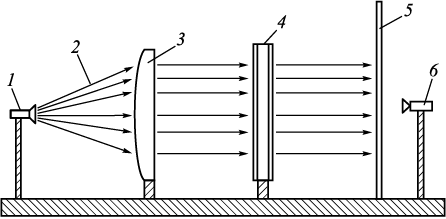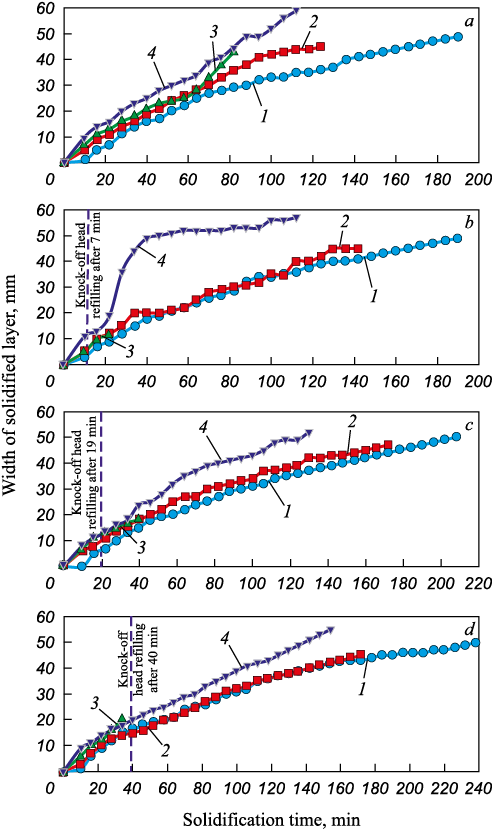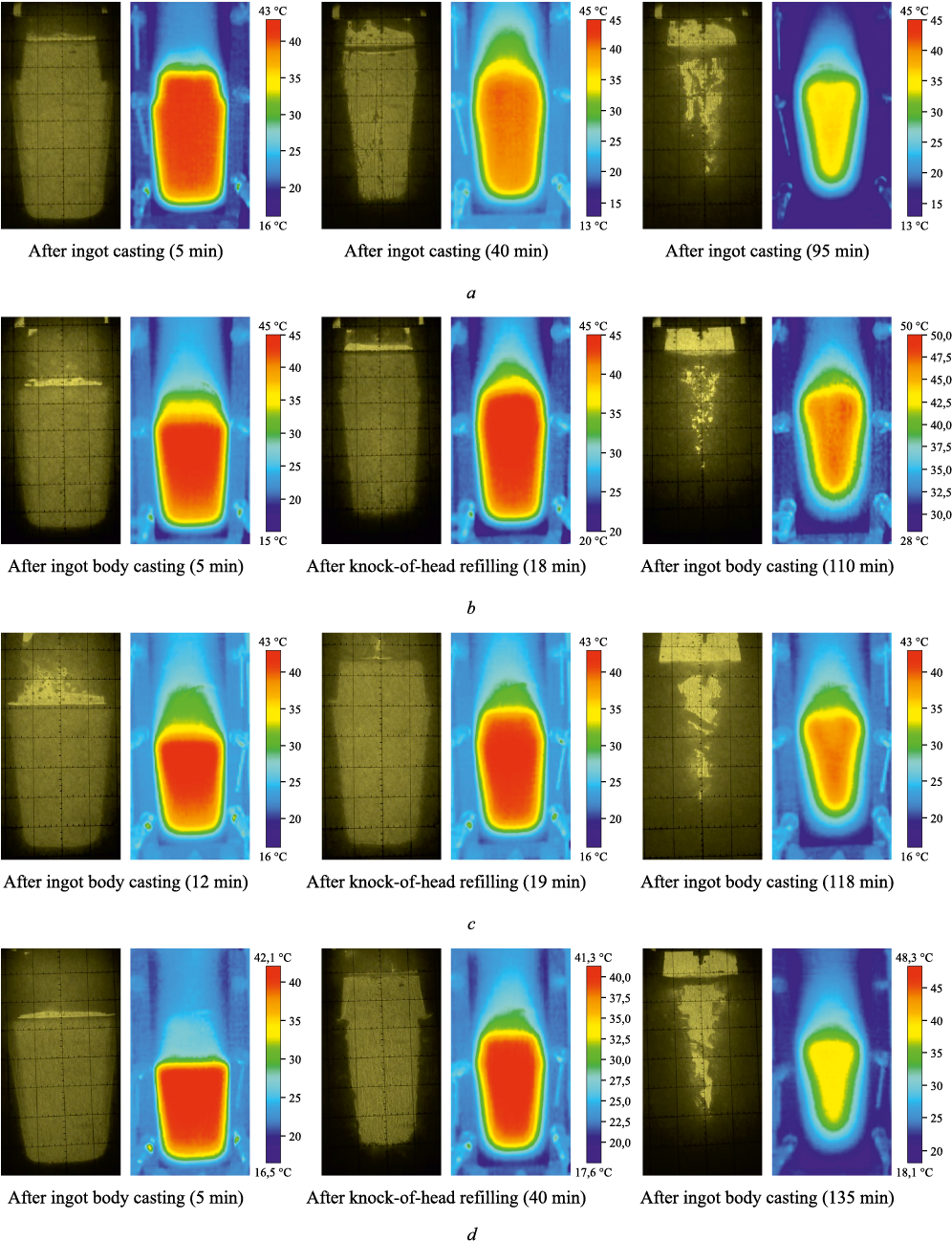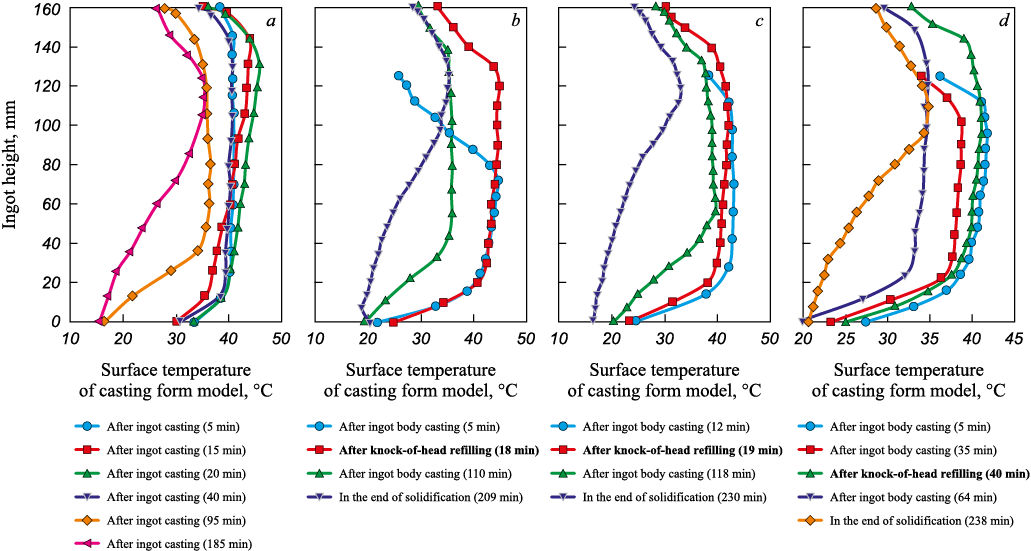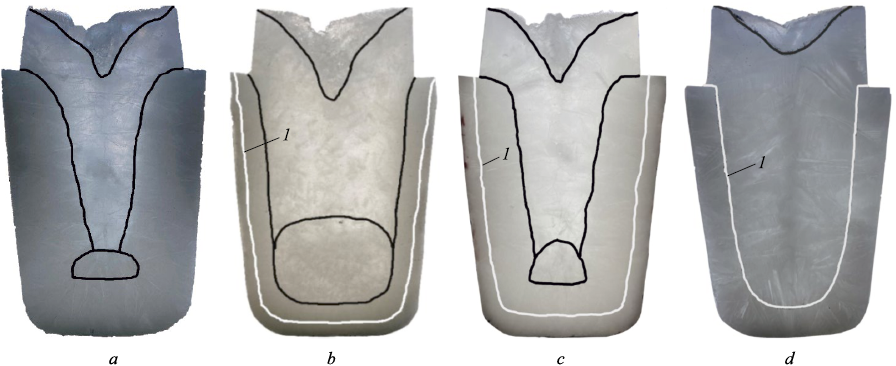Scroll to:
Physical modeling of the effect of refilling the melt into an ingot knock-off head on solidification and structure formation
https://doi.org/10.17073/0368-0797-2023-6-750-759
Abstract
The paper presents the results of a laboratory study of the effect of refilling the ingot knock-off head with melt in a certain time interval after pouring the ingot body on solidification and structure formation of the model ingot. The research was carried out by the method of physical (cold) modeling for which a laboratory installation (casting form-mold) was developed and manufactured. It allows visually studying the processes occurring during solidification and structure formation on a 19.6-ton model ingot. We used sodium sulfuric acid (crystalline hyposulfite) as a modeling solution. Correspondence of the processes occurring on the model and in real conditions of industrial ingots casting was evaluated using similarity criteria obtained on the basis of dimension theory with analysis of physico-chemical processes occurring during casting and crystallization of the ingot. Casting of the melt into the casting form-mold was downhill. In order to assess changes in the temperature field during casting and crystallization of the ingot in the entire solidification time, we performed thermometry of the mold model surface. Analysis of the conducted studies results showed that refilling the melt before 40 min leads to stimulation of early settling of crystals (“rain of crystals”), which contributes to an increase in the crystallization directivity in vertical direction. It was established that in a conventional ingot up to 40 min solidification proceeds by a sequential mechanism, and after that the crystals begin to settle (“rain of crystals”) and the solidification of the ingot passes through a volume-sequential mechanism. Refilling the ingot knock-off head with melt 40 min after pouring the ingot body contributed to the continuation of the sequential mechanism of ingot solidification, which led to the formation of a monolithic defect-free structure in the ingot body and the least development of shrinkage shell in the knock-off head. The results obtained make it possible to develop a technology for differentiated ingots casting when filling their knock-off heads with melt in a certain time interval after pouring the ingot body, which will affect the process of metal structure formation and reduce defective zones.
Keywords
For citations:
Gamanyuk S.B., Rutskii D.V., Zyuban N.A., Kirilichev M.V., Nikitin M.S. Physical modeling of the effect of refilling the melt into an ingot knock-off head on solidification and structure formation. Izvestiya. Ferrous Metallurgy. 2023;66(6):750-759. https://doi.org/10.17073/0368-0797-2023-6-750-759
Introduction
The theory and practice of ingot production demonstrate that the solidification time of large ingots spans several days, during which liquation and shrinkage phenomena significantly manifest. These phenomena give rise to chemical and physical heterogeneity within the cast metal, which, if pronounced, may persist even after forging. Consequently, this can result in the rejection of billets either during manufacturing or during delivery trials, leading to losses for the enterprise.
Currently, numerous methods have been developed to enhance metal quality, primarily focusing on process improvements during smelting and casting. However, despite advancements, the benefits achieved during smelting can be compromised during the casting and solidification of large ingots, each weighing no less than 14 tons.
Studies [1 – 3] demonstrate that challenges in achieving structural quality and uniform mechanical properties throughout the height and radius of forgings stem from varying solidification conditions across different parts of the ingot. Additionally, shrinkage processes, significant liquation of impurities in the steel composition, and the shape and size of the ingot contribute to these difficulties.
The significant influence of ingot geometrical parameters on the development of the axial zone is widely acknowledged. Specifically, parameters such as the height to average diameter ratio H/D [4 – 7], conicity [8 – 10], and the type of the ingot (shortened, normal, elongated) are recognized as predominant factors.
The formation of axial porosity is closely linked to shrinkage phenomena, which are, in turn, influenced by temperature conditions and thermophysical processes during ingot casting and crystallization. Consequently, the method and speed of metal casting are crucial determinants in the formation of axial defects in the ingot [11 – 13].
To enhance the quality of large ingots, it’s imperative to explore effective methods that influence the solidification process. Understanding the mechanisms and conditions leading to the formation of localized defect areas, which contribute to the development of macro-defects resistant to deformation removal, is essential. Analyzing the solidification features of large ingots is intricate, requiring consideration of numerous factors impacting crystallization phenomena.
One approach to studying solidification processes in large ingots is through physical (cold) modeling, utilizing casting form models [14 – 16]. This method enables the visual assessment of solid and solid-liquid phase advancement kinetics alongside convective mixing of the modeling melt and internal defect development. It’s important to note that physical modeling provides qualitative insights into the influence of casting process factors on structure formation nuances and defect zone development.
The conditions outlined in [2; 3; 17] suggest that refilling the knock-off head is justified when the ratio of crystallization interval value to temperature gradient value meets the criterion ΔТcr /δТ ≥ 1. Researchers in [18] demonstrated that refilling the knock-off head with hot melt can significantly impact ingot structural zone formation conditions, elevating the δT parameter to values prompting a return to sequential solidification, resulting in a denser dendritic structure.
The aim of this research is to investigate the impact of refilling the knock-off head with melt on the solidification process and structure formation of the model ingot. Refilling is executed at specific time intervals following casting of the ingot body.
Materials and methods
In this study, we employed the physical (cold) ingot modeling method, for which we designed and fabricated a laboratory installation (casting form-mold) [16]. Using this installation, we visually examined the processes occurring during solidification and structure formation of model ingots. The geometric parameters of both real industrial and model ingots are detailed in Table 1.
Table 1. Geometrical parameters of industrial and model ingots
|
As a modeling solution, we utilized sodium thiosulfate (crystalline hyposulfite) – Na2S2O3·5H2O was used as a modeling solution. The solidification onset temperature ranged from 48 to 52 °C. To evaluate the correspondence between the processes observed in the model and those in real industrial ingot casting conditions, we employed similarity criteria, including Froude (Fr), Reynolds (Re), Weber (We), Biots (Bi), and Fourier homochronicity (Fo). These criteria were derived from dimensional analysis of physical and chemical processes during ingot casting and crystallization. Additionally, we utilized the solidification criterion (phase transfer) N, describing the ratio of phase transfer heat to cooling heat [4; 19].
Calculation of the similarity criteria (Bi, N, Fo, Fr, We) as outlined in [4] demonstrated (see Table 2) that their values for both model and real conditions differed by no more than one order of magnitude, indicating correspondence between the studied processes [19].
Table 2. Values of similarity criteria in the sample and model
| ||||||||||||||||||||||||||
The direct shadow method, also known as the schlieren method, was employed to examine the hydrodynamic characteristics of liquid motion at the end of casting into the casting form – mold, as well as the behavior of convective flows (both downward and upward) in the melt during the solidification process. This method facilitated visualization and quantification of the nature and rate of change of convective flows during the solidification of model ingots.
The direct shadow method (Fig. 1), involves generating a parallel beam of light 2 using a light source and collecting lens 1, which is then directed to “shine through” the object under examination (casting form – mold) 4. When encountering inhomogeneity, the rays deflected by it form an image projected onto a screen 5. To ensure the light beam’s parallelism, in this study, the light was directed to a straight mirror 3 whose size matches that of the mold. Light 2 reflected by the mirror 3 from the source 1, while passing through the solidifying ingot model within the casting form – mold 4, reveals the image of inhomogeneity on the screen 5, which was captured using a high-resolution digital video camera 6. The video recordings obtained were utilized to calculate the velocities of convective flows immediately after casting and during the solidification of the model ingot. To calculate these velocities, a grid with square side dimensions of 25 mm was applied to the screen.
Fig. 1. Layout of installation for studying the solidification |
The melt was poured into the casting form – mold from above, and the experimental conditions’ specifics are detailed in Table 3.
Table 3. Characteristics of the experimental conditions
| ||||||||||||||||||||||||||||||||||||||||||||||||||||||||||||||||||||||||||||
Four model ingots were cast using the physical (cold) modeling method to simulate the ingot solidification process. One ingot followed classical technology (referred to as an ordinary ingot), while the others had the head cast after different time intervals: 7, 19 and 40 min after casting the ingot body (referred to as experimental ingots or refilling of the head after 7, 19 and 40 min). Refilling of the knock-off head of experimental ingots was performed with melt temperature 5 °C “colder” than the melt used for casting the ingot body. At the time of refilling, the solidified solid phase area in the body of experimental ingots (zone of columnar crystals) amounted to 16.7, 23.5 and 43.4 %, respectively (Table 1). Throughout the ingot modeling process, the geometric parameters of casting remained constant (Table 1).
During modeling, the advancing solidification front was analyzed in two components: horizontal solidification, where the solid phase sequentially grows from the walls to the center of the casting form, and vertical solidification vertical solidification, where the solid phase advances from the walls to the center along the axis of the casting form.
Following the casting of the melt into the casting form-mold, the thickness of the solidified layer was measured every 5 min vertically from the bottom to the center of the casting form along the axis and at three levels along the height of the ingot (bottom section, middle height, and sub-knock-off head horizon).
At the end of the solidification process, the structural zones of model ingots and their volume fractions were measured, and the length and average width of the axial zone were determined. The impact of the time interval for refilling the knock-off head with melt on the crystallization rate and the dynamics of solid phase growth in model ingots in both vertical and horizontal solidification directions, as well as on the total solidification time, was assessed.
To evaluate changes in the temperature field during casting and crystallization of the ingot, thermometry of the casting form model surface was conducted throughout the solidification period. Initially, after casting completion, the crystallizing melt was photographed every 5 min for 30 min, followed by intervals of 20 min. Thermometry was performed using a thermal camera Testo 875i, and the thermal images obtained were processed using TestoIRSoft software. As the thermal camera allows only surface thermometry without direct measurement of melt temperature, the dynamics of melt temperature change were assumed to mirror the dynamics of surface temperature change of the casting form model, providing a qualitative insight into the temperature field variations.
Results and discussion
The data processing resulted in the preparation of curves illustrating the solid phase growth rate in both vertical and horizontal solidification directions for various ingot casting techniques (Fig. 2).
Fig. 2. Curves of solid phase growth in height and cross section |
Analysis of the results revealed that for an ordinary ingot (Fig. 2, a) and an ingot with head refilling after 7 min (Fig. 2, b), between 10 and 73 min, constituting 5 to 38 % of the total solidification time, structure formation follows a volume-sequential mechanism. This mechanism arises due to the settling of crystal fragments from the “mirror” of the melt in the head and near the solidification front. These fragments sink to the lower part of the ingot, forming a cone-shaped settling zone. The descending crystals enhance the vertical solidification rate, thereby increasing the orientation of ingot solidification. Consequently, this phenomenon results in reduced development of axial friability and chemical heterogeneity in the ingot [1]. Subsequent solidification of the ingot proceeds in the horizontal direction via a sequential mechanism.
It’s noteworthy that in the experimental ingot, the “rain of crystals” commenced immediately after refilling the head with melt and persisted for over 50 min, whereas in the ordinary ingot, crystal settling began only after 40 min and lasted for 30 min. Furthermore, during the initial 40 min of solidification in the experimental ingot (21 % of the total solidification time), the width of the solid phase in the vertical direction was twice that of the ordinary ingot. This suggests that refilling the head with “cold” melt (at 70 °C) into the “hot” melt (at 75 °C), with only 7 min elapsed since casting the ingot body, resulted in an increased temperature gradient and the emergence of crystallization centers. Consequently, this contributed to the formation of a dense “rain” of crystals and accelerated the advancement of the solidification front in the vertical direction. Additionally, the introduction of a portion of melt induced forced convection, leading to the displacement of crystals from the crystallization front into the settling cone zone.
In the ingot with head refilling after 19 min (Fig. 2, c) solidification occurred according to the volume-sequential mechanism from 32 to 79 min (15 to 38 % of the total solidification time) due to crystal settling.
For the ingot with head refilling after 40 min (Fig. 2, d), solidification occurred via the sequential mechanism from the walls to the ingot axis, without the “rain of crystals” phenomenon typically observed in ingots of this experimental series.
Thermometry of the casting form model surface during solidification of an ordinary ingot revealed (Figs. 3, a; Fig. 4, a) that during the initial half of the ingot solidification time, the thermal center was located in the sub-knock-off head horizon. Subsequently, it shifted to the ingot mid-height, and by the end of solidification, it returned to the sub-knock-off head horizon. This observation aligns with existing concepts regarding the solidification process of large ingots [1; 2].
Fig. 3. Dynamics of the thermal center movement during solidification of model ingots:
Fig. 4. Change in surface temperature of the casting form model in height of the model ingots |
For the ingot with head refilling after 7 min (Fig. 3, b; Fig. 4, b), the thermal center remained consistent, moving only from the middle to 2/3 of the ingot height throughout the solidification process, eventually settling at the sub-knock-off head horizon by the end of solidification. Similarly, for the ingot with head refilling after 19 min (Fig. 3, c; Fig. 4, c), the thermal center remained at the ingot mid-height throughout solidification, eventually shifting to the sub-knock-off head horizon at the end. In contrast, for the ingot with head refilling after 40 min (Fig. 3, d; Fig. 4, d), the thermal center was initially located at 2/3 of the ingot height, moving to the sub-knock-off head horizon after melt refilling and remaining there until the end of solidification.
It’s evident that melt refilling influenced the dynamics of thermal processes during ingot crystallization.
Analysis of structural zone development in model ingots (Table 4, Fig. 5) revealed that three ingots (Fig. 5, a – c) exhibited the development of a settling cone zone. Two ingots (Fig. 5, a, b) were characterized by the penetration of a shrinkage hole from the head to the ingot body, which is evidently an ingot defect.
Fig. 5. Macrostructure of the model ingots:
Table 4. Volume fractions of structural zones in the model ingots
| ||||||||||||||||||||||||||||||||||
Visual inspection of the macrostructure of the cast ingots revealed that the ingot with head refilling conducted after 40 min (Fig. 5, d) exhibited a dense and defect-free structure.
This suggests that refilling the head with melt 40 min after casting the ingot body influenced the ingot crystallization mechanism, causing it to solidify via the sequential mechanism from the ingot walls to the axis, without the occurrence of the “rain of crystals” phenomenon. This process promoted the growth of columnar crystals toward the ingot axis, resulting in minimal development of a shrinkage hole and ultimately yielding a defect-free structure.
Conclusions
It has been observed that in an ordinary ingot, solidification proceeds via a sequential mechanism up to 40 min, after which crystals begin to settle (“rain of crystals”), transitioning the solidification process to a volume-sequential mechanism. However, refilling the knock-off head with melt 40 min after casting the ingot body sustained the sequential mechanism of ingot solidification. This resulted in the formation of a monolithic, defect-free structure in the ingot body and minimized the development of shrinkage holes in the head volume.
Melt refilling within the initial 40 min stimulates early crystal settling (“rain of crystals”), enhancing crystallization orientation in the vertical direction.
Thermometry of the casting form-mold surface during ingot solidification revealed the influence of melt refilling of the head on the dynamics of thermal processes occurring during crystallization.
These findings provide insight into the development of differentiated casting technology for ingots, wherein the head is filled with melt at specific intervals after casting the ingot body. This approach can effectively influence the metal structure formation process and reduce defect zones.
References
1. Skoblo S.Ya., Kazachkov E.A. Ingots for Large Forgings. Moscow: Metallurgiya; 1973:247.
2. Smirnov A.N., Makurov S.L., Safonov V.M., Tsuprun A.Yu. Large Ingot. Donetsk: Veber; 2009:279.
3. Zhul’ev S.I., Zyuban N.A., Rutskii D.V. Steel Ingots: Quality and New Technologies. Volgograd: VolgSTU; 2016:176. (In Russ.).
4. Gamanyuk S.B. Investigation of a large forging steel ingot of modified geometry in order to improve the quality of metal forgings: Cand. Tech. Sci. Diss. Volgograd; 2012. (In Russ).
5. Jiaqi W., Paixian F., Hongwei L., Dianzhong L., Yiyi L. Shrinkage porosity criteria and optimized design of a 100-ton 30Cr2Ni4MoV forging ingot. Materials & Design. 2012;35:446–456. https://doi.org/10.1016/j.matdes.2011.09.056
6. Zhang C.-J., Bao Y.-P., Wang M. Influence of casting parameters on shrinkage porosity of a 19 ton steel ingot. Metallurgia Italiana. 2016;108(1):37–44.
7. Yu Z., Zhang H., Wang X., Wu X. Study on heat transfer characteristics during solidification of 18-ton steel ingot with large ratio of height to diameter. Metallurgia Italiana. 2020;112(5):37–47.
8. Tashiro K., Watanabe S., Kitagawa I., Tamura I. Influence of mould design on the solidification and soundness of heavy forging ingots. Transactions of the Iron and Steel Institute of Japan. 1983;23(4):312–321. https://doi.org/10.2355/isijinternational1966.23.312
9. Romashkin A.N., Malginov A.N., Tolstyh D.S., Ivanov I.A., Doub V.S. The ingot geometry effect on the axial shrinkage. Computer Research and Modeling. 2015;7(1):107–112. (In Russ.). https://doi.org/10.20537/2076-7633-2015-7-1-107-112
10. Zhang C., Bao Y., Wang M., Guo B. Influence of casting parameters on the shrinkage porosity of a 40-ton steel ingot by numerical simulation. In: Proceedings of the 6th Int. Congress on the Science and Technology of Steelmaking, 2015. 2015:543–546.
11. Zhang C., Loucif A., Jahazi M., Morin J.-B. FE modelling and prediction of macrosegregation patterns in large size steel ingots: Influence of filling rate. Metals. 2022;12(1):29. https://doi.org/10.3390/met12010029
12. Zhang C., Loucif A., Jahazi M., Tremblay R., Lapierre L.-P. On the effect of filling rate on positive macrosegregation patterns in large size cast steel ingots. Applied Sciences (Switzerland). 2018;8(10):1878. https://doi.org/10.3390/app8101878
13. Marx K., Rödi S., Schramhauser S., Seemann M. Optimization of the filling and solidification of large ingots. Metallurgia Italiana. 2014;106(11–12):11–19.
14. Ludwig A., Stefan-Kharicha M., Kharicha A., Wu M. Massive formation of equiaxed crystals by avalanches of mushy zone segments. Metallurgical and Materials Transaction A. 2017;48:2927–2930. https://doi.org/10.1007/s11661-017-4008-y
15. Stefan-Kharicha M., Kharicha A., Mogeritsch J., Wu M., Ludwig A. Review of ammonium chloride-water solution properties. Journal of Chemical & Engineering Data. 2018;63(9):3170–3183. https://doi.org/10.1021/acs.jced.7b01062
16. Gamanyuk S.B., Zyuban N.A., Rutskii D.V., Palatkin S.V. Device for studying the crystallization process of ingots in a mold. Patent RF no. 169365. Bulliten’ izobretenii. 2017:(8). (In Russ.).
17. Efimov V.A., Eldarkhanov A.S. Modern Technologies for Casting and Crystallization of Alloys. Moscow: Mashinostroenie; 1998:359. (In Russ.).
18. Gorunov A.I., Naumenko V.V., Rutskii D.V. Effect of refilling the knock-off head on solidification and structure formation of 38KhN3MFA steel ingot. News of the Volgograd State Technical University. Series “Problems of materials science, welding and strength in mechanical engineering”. Issue 2: Interuniver. Coll. of Sci. Papers. 2008;10:157–159. (In Russ.).
19. El’darkhanov A.S., Efimov V.A., Nuradinov A.S. Processes of Castings Formation and Their Modeling. Moscow: Mashinostroenie; 2001:208.
About the Authors
S. B. GamanyukRussian Federation
Sergei B. Gamanyuk, Cand. Sci. (Eng.), Assist. Prof. of the Chair “Materials Technology”
28 Lenina Ave., Volgograd 400005, Russian Federation
D. V. Rutskii
Russian Federation
Dmitrii V. Rutskii, Cand. Sci. (Eng.), Assist. Prof., Head of the Chair “Materials Technology”
28 Lenina Ave., Volgograd 400005, Russian Federation
N. A. Zyuban
Russian Federation
Nikolai A. Zyuban, Dr. Sci. (Eng.), Prof. of the Chair “Materials Technology”
28 Lenina Ave., Volgograd 400005, Russian Federation
M. V. Kirilichev
Russian Federation
Mikhail V. Kirilichev, Head of the Laboratory of the Chair “Materials Technology”
28 Lenina Ave., Volgograd 400005, Russian Federation
M. S. Nikitin
Russian Federation
Maks S. Nikitin, Postgraduate of the Chair “Materials Technology”
28 Lenina Ave., Volgograd 400005, Russian Federation
Review
For citations:
Gamanyuk S.B., Rutskii D.V., Zyuban N.A., Kirilichev M.V., Nikitin M.S. Physical modeling of the effect of refilling the melt into an ingot knock-off head on solidification and structure formation. Izvestiya. Ferrous Metallurgy. 2023;66(6):750-759. https://doi.org/10.17073/0368-0797-2023-6-750-759


